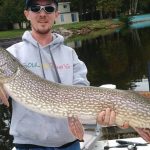By approving regulations that limit or possibly close numerous marine fisheries to recreational fishing despite a lack of scientific data, the Gulf of Mexico and South Atlantic Fishery Management Councils (SAFMC) have once again landed the federal fisheries management process in hot water with the sportfishing community. These regulations, which still require the Secretary of Commerce’s approval, may affect fishing practices and seasons for numerous recreationally important stocks such as dolphin, wahoo and dozens of species in the snapper-grouper complex. The Councils’ decision-making process is being driven by a December 31, 2011, deadline for annual catch limits and accountability measures in the 2006 Magnuson-Stevens Fishery Conservation and Management Act (MSA) reauthorization which the sportfishing community believes requires Congressional action to amend.
These catch limits are intended to be set based on quality, up-to-date data on fish stocks, such as catch, biological characteristics and abundance measures. However, this important information is lacking for the majority of stocks in the South Atlantic and Gulf of Mexico, and as a result managers are using alternative, inadequate metrics on which to base annual catch limits. In addition to setting overly precautionary annual catch limits because of a lack of data, the Councils have also removed numerous stocks from management plans. Once these fish stocks are dropped from federal management, they are no longer protected under federal regulations that control fishing pressure and techniques.
To address the problems the Councils are facing regarding annual catch limit requirements, on June 22, 2011, the Fishery Science Improvement Act, H.R. 2304, was introduced in the U.S. House of Representatives by Rep. Rob Wittman (R-VA). This legislation – which currently has bi-partisan support from 26 additional Congress members – removes the requirement to implement annual catch limits on stocks for which there is inadequate data and no evidence of overfishing. For more information, read the Fishery Science Improvement Act Fact Sheet.
“The recreational fishing community isn’t against annual catch limits per se, but we are against setting them based on guesswork,” said American Sportfishing Association (ASA) President and CEO Mike Nussman. “Most of the annual catch limits that have been set in the South Atlantic and Gulf of Mexico are based simply on recent landings instead of the suite of fishery data needed for solid population assessment. Quality data should be used to determine the optimum amount of harvest that can be taken to allow for sustainable fishing. If this new, arbitrary catch level is exceeded on a given species, the Councils are going to treat that as overfishing and shut down that fishery, and possibly many others, even though there’s no evidence to suggest that the stock is in trouble. This is a problem rooted in the MSA that must be fixed immediately.”
Nussman further said, “We hope Congress will pass this commonsense, bipartisan and simple solution before the end of the year. This nation’s 24.7 million saltwater anglers and the $82.3 billion economy they support are depending on it.”
In recent testimony provided to the House Natural Resources Subcommittee on Fisheries, Wildlife, Oceans and Insular Affairs, past SAFMC chairman and current SAFMC member Duane Harris echoed many of the same concerns held by the recreational fishing community. “Without reliable fisheries independent and dependent data streams, true stock status cannot be determined,” commented Harris. “This is the scenario the Council and Scientific and Statistical Committee find themselves in many instances, dictating a precautionary approach to management. This generally results in low Allowable Biological Catch and Annual Catch Limits, ultimately restricting harvest, not because the stock status is known to be in bad shape, but because not enough information is available to make an accurate assessment.”
“The fact that the Councils are dropping species from management altogether shows that there is a major problem here,” said Ken Haddad, ASA’s Marine Fisheries advisor. “To make matters worse, new data on most species are expected later this year that could completely change the annual catch limits forcing the Councils to redo all the work to date. This is federal bureaucracy at its worst and public confusion at its best.”
Haddad concluded, “If the Councils are forced to develop ‘work around’ solutions for annual catch limits, then it is abundantly clear that the MSA is flawed and must be modified as opposed to just finding a way around the challenge.”
The American Sportfishing Association (ASA) is the sportfishing industry's trade association, committed to looking out for the interests of the entire sportfishing community. We give the industry a unified voice speaking out when emerging laws and policies could significantly affect sportfishing business or sportfishing itself. We invest in long-term ventures to ensure the industry will remain strong and prosperous as well as safeguard and promote the enduring economic and conservation values of sportfishing in America. ASA also gives America’s 60 million anglers a voice in policy decisions that affect their ability to sustainably fish on our nation’s waterways through KeepAmericaFishing, our angler advocacy campaign. America’s anglers generate over $45 billion in retail sales with a $125 billion impact on the nation's economy creating employment for over one million people.













